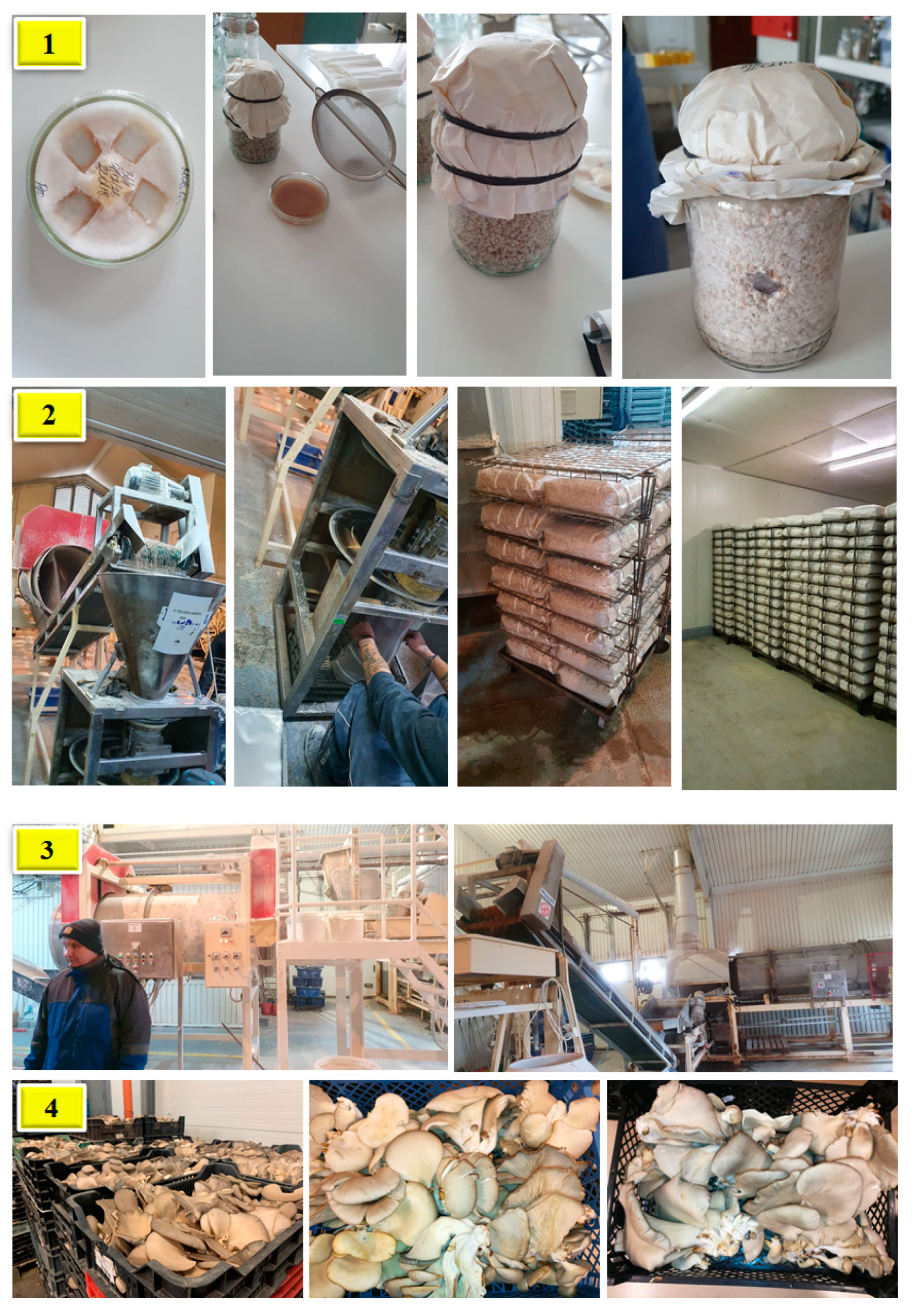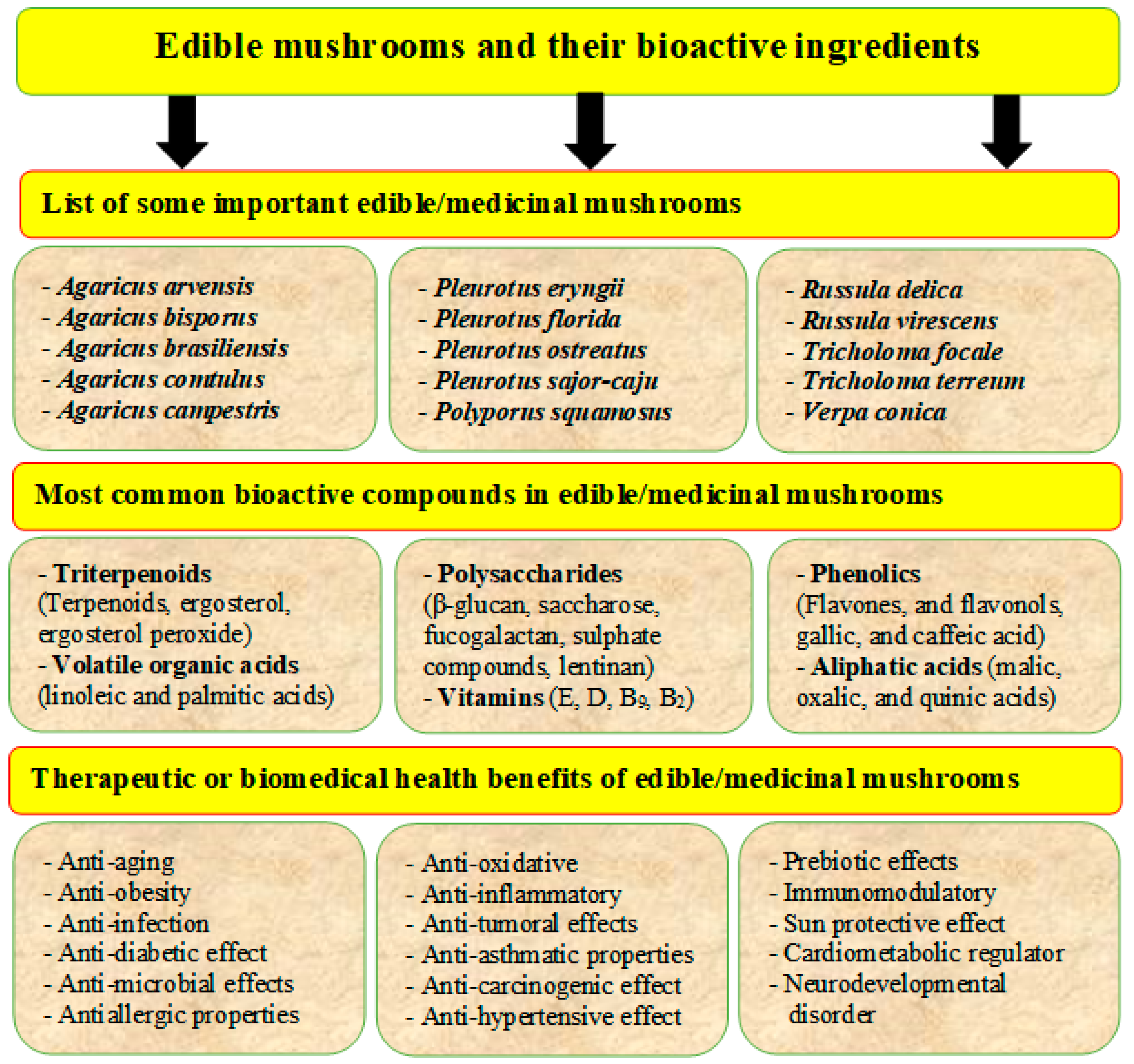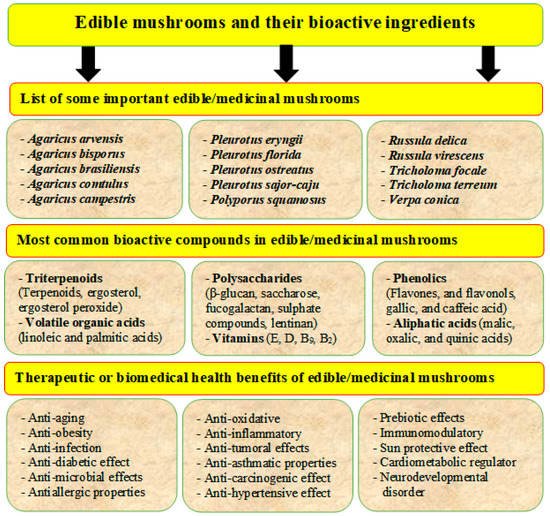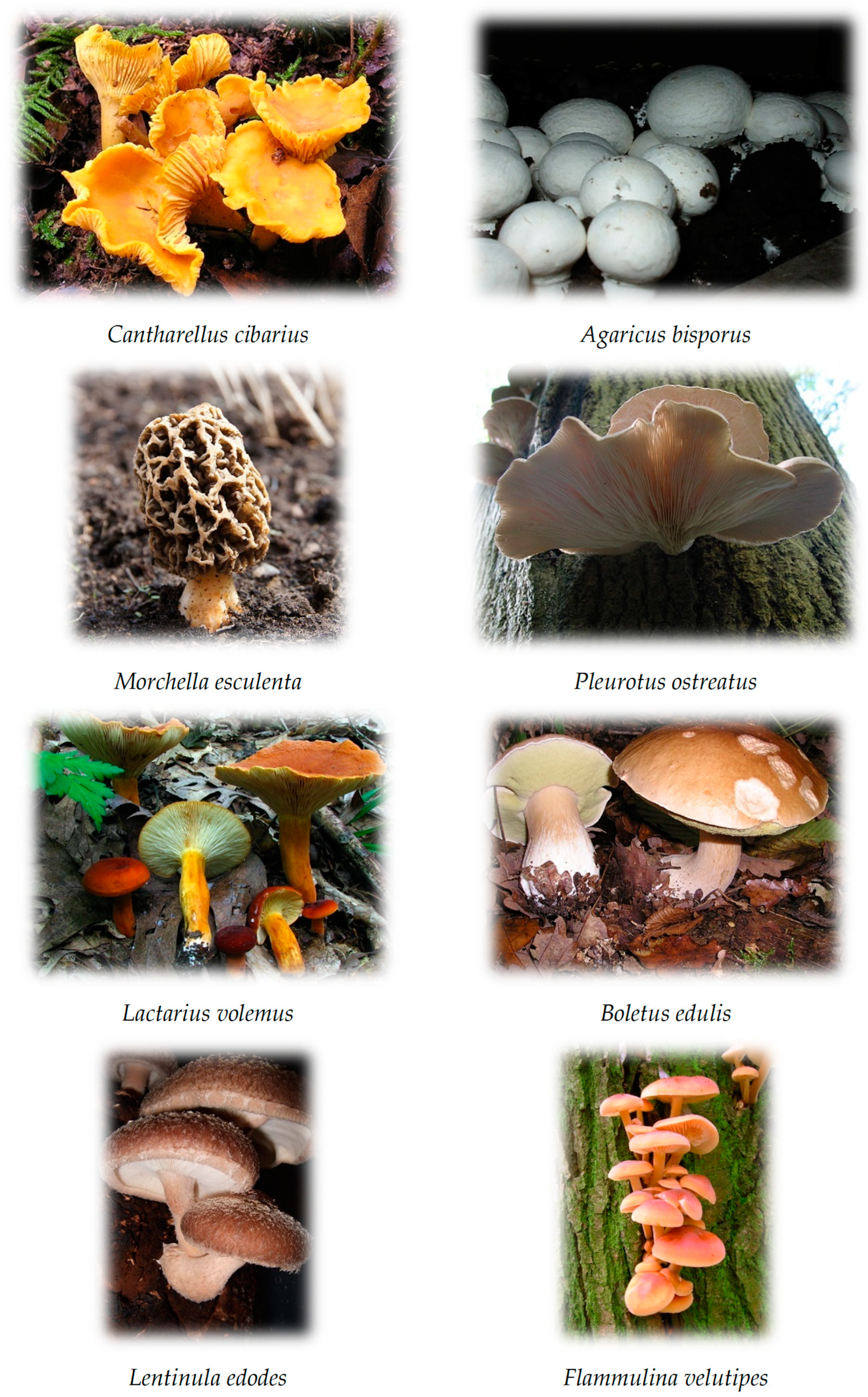Your browser does not fully support modern features. Please upgrade for a smoother experience.
Please note this is a comparison between Version 1 by Hassan Ragab El-Ramady and Version 4 by Hassan Ragab El-Ramady.
Edible mushrooms are considered an important next-generation healthy food source. Edible mushrooms are rich in proteins, dietary fiber, vitamins, minerals, and other bioactive components (alkaloids, lactones, polysaccharides, polyphenolic compounds, sesquiterpenes, sterols, and terpenoids).
- anticancer
- antidiabetic
- antioxidants
- phenolics
- poisonous mushroom
- biomolecules
13. Sustainable Production of Edible Mushrooms
More than 100 countries cultivate edible mushrooms commercially using different systems and on different scales. The global production of mushrooms increases annually at growth rate of about 7%. The current global consumption of mushrooms is around 12.74 million tonnes, and it is predicted that the global production of mushrooms will scale to 20.84 million tonnes by 2026 [1][29]. Mushrooms can be classified into some categories including (1) cultivated mushrooms (which can be grown commercially by farmers using various strategies to produce for sale at supermarkets; these include enoki and oyster mushrooms), (2) wild mushrooms (which can grow on the root systems of trees in forests and are harvested by mushroom hunters—lots of wild mushrooms are poisonous), (3) medicinal mushrooms (several mushrooms have medicinal benefits but might not always be pleasant to consume), and (4) poisonous mushrooms, which have toxic substances or toxins [2][30]. Based on the growing method of mushrooms, they can be classified into saprotrophic mushrooms (sapro = rot; troph = eating), which grow on dead matter; mycorrhizal mushrooms (mykes = fungus; rhiza = root), which have a symbiotic relationship (sym = together; biosis = way of living) with crops or trees; and parasitic mushrooms, which infect and depend on its host plant and then kill it [2][30].
Most cultivated mushrooms have a basic life cycle, which includes the following stages (1) sporulation (i.e., production spores not seeds), (2) spore germination and the mating of cells, (3) colonization to complete fruiting initiated, (4) the formation of primordia, and (5) after fruiting or mature of mushrooms, spores release again and the cycle repeats (Figure 1) [3][31]. The cultivation steps can be summarized in terms of seven stages, as presented in Figure 2 and described in [3][31]. The sustainable production of mushrooms is important because mushrooms are considered edible foods and are high in protein content. There are many poisonous mushrooms, which must be clear to consumers in order to avoid causing serious ecological and health problems [4][32]. The huge amount of wastes that result from mushroom cultivation needs to be sustainably recycled for in order to protect the environment and to produce the bioenergy as well. Therefore, edible mushrooms can be promoted as an important agri-business activity to address many environmental issues, especially the ecological degradation [1][5][29,33]. The cultivation of mushrooms can be used to manage farm wastes by recycling them, as well as to dispose of spent mushroom substrate “SMS” (i.e., wastes remaining after harvesting mushrooms). On the other hand, the cultivation of mushrooms should protect from many competitor microorganisms and promote hygiene, which are controlled through the environmental conditions as presented in Table 1 [6][34].


Figure 1. The industry of mushroom cultivation is considered an important industry, which needs certain steps to produce the edible mushrooms as presented in these photos. The first group of photos (1) includes mushroom fungi (Pleurotus ostreatus) culture, which should first be ready on the surface of agar plate beside the cultivation substrates, as well as tools for propagation of mushroom and poured media (heat treated at 95 °C, for 1 day). The inoculant and the millet spawn in a jar should be also prepared. The second and third group of photos (2,3) include the industrial preparing and filling of spawn in the factory, whereas the group of photos in (4) represent oyster mushroom production. These steps have been photographed from the factory of “Magyar Gomba Kertész Kft”, and all photos were taken by Gréta Törős, Debrecen University, Hungary.


Figure 2.
Different stages of mushroom cultivation starting from preparation of media till harvesting.
Table 1.
The environmental conditions controlling the most commonly cultivated species as ideal values, but certain strains may exceed them.
| Environmental Conditions | Spawn Run | Primordia Formation | Fruitbody Development | |||||
|---|---|---|---|---|---|---|---|---|
| Temperature | 21–27 °C | 10–21 °C | 10–24 °C | |||||
| ] | [ | 98 | , | 99 | Relative Humidity | 85–95% | 95–100% | 80–90% |
| Light | 50–100 lux | 1000–1500 lux | 1000–1500 lux | |||||
| CO2 level | 5000–20,000 ppm; 1 FAE/h | 500–2000 ppm; 4–8 FAE/h | <1000–2000 ppm; 4–8 FAE/h | |||||
| Duration | 2–8 weeks | 3–12 days | 5–8 days |
2. Bioactive Ingredients of Edible Mushrooms
Edible mushrooms contain various bioactive ingredients such as proteins, polysaccharides, polyunsaturated fatty acids (PUFA), dietary fibers, amino acids, vitamins, and minerals (Table 25). They have essential health effects, such as antioxidant, antimicrobial, immune-stimulatory, and anticancer, cholesterol-lowering properties (Figure 36) [7][8][9][10][12,37,38,39]. Several significant components and secondary metabolites dominate their biological activity. Lectins are carbohydrate-binding proteins that can be found in many types of edible mushrooms such as Phaseolus vulgaris, Agaricus campestris, Agaricus bisporus, Grifola frondosa, Boletus satanus, Flammulina velutipes, Tricholoma mongolicum, Ganoderma lucidum, and Volvariella volvacea. Lectins have been shown to increase insulin secretion, activate the immune system, and have anticancer effects [11][8]. Lectins can also play essential roles in physiological processes such as dormancy, growth, morphogenesis, morphological changes, and molecular recognition in the early stages of mycorrhization. Lectins isolated from the edible mushroom Clitocybe nebularis exhibit immunostimulatory effects on the most potent antigen-presenting cells, dendritic cells [12][94].


Figure 36. Edible mushrooms are an important source of human food and have several bioactive ingredients (phenols, lectins, terpenoids, flavonoids, etc.) and bio-medicinal activities such as anticancer, antidiabetic, antiaging, antiviral, antioxidant, and anti-inflammatory.
Table 25.
A list of some phenolic compounds, polysaccharides, proteins, and triterpenoids found in selected edible mushrooms species.
| Edible Mushrooms | Phenolics | Polysaccharides | Proteins | Triterpenoids | Refs. |
|---|---|---|---|---|---|
| Agaricus bisporus | Gallocatechin | Heteropoly-saccharide ABP | Protein type FIIb-1 | Ergosterol | [13][14][15][16,100,101] |
| Boletus edulis | Gallic acid | Polysaccharides (BEBP-1) | β-Trefoil lectin | Boledulins A-C | [13][17][18][19][98,102,103,104] |
| Cordyceps aegerita | Proto-catechuic acid | Fucogalactan | Ageritin | Bovistols A-C | [20][21][22][23][105,106,107,108] |
| Coprinus comatus | Flavones, and flavonols | Modified polysaccharide | Laccases | Terpenoids | [24][25][109[26],110,111] |
| Lactarius deliciosus | Syringic acid, vanillic acid | Polysaccharide (LDG-M) | Laccase | Azulene-type sesquiterpene | [27][28][29][30][112,113,114,115] |
| Pleurotus ostreatus | Caffeic acid, and ferulic acid | Mycelium polysaccharides | Concanavalin A | Ergosterol | [31][116] |
| Pleurotus eryngii | Cinnamic acid | PEPE-A1 and PEPE-A2 | Laccase | Ergosterol | [32][33][117,118] |
| Pleurotus cornucopiae | Gallic acid | β-glucan | Oligopeptides | Ergostane-type sterols | [34][35][36][37][119,120,121,122] |
| Macrolepiota procera | Proto-catechuic acid | Polysaccharides | β-Trefoil lectin | Lanostane triterpenoids | [18][[40][10338][39],123,124,125] |
| Russula virescens | Quercetin | SRVPs | Laccase | ---------- | [41][42][43][126,127,128] |
| Tuber melanosporum | Flavonoids, phenols | Exo-poly-saccharides (TP1) | ------------- | Ergosterol | [16][35][36][37][38][39][40][41][42][43][44][101,120,121,122,123,124,125,126,127,128,129] |
Glucans are one of the unique ingredients in mushrooms that have immune-stimulatory, anticancer, anti-inflammatory, and antioxidant effects. They can be found in different types of edible mushrooms such as Jelly ears (Auricularia auricular), Reishi (Ganoderma lucidum), Shiitake (Lentinula edodes), and Oyster (Pleurotus ostreatus) [45][95]. For example, beta-glucan, isolated from Pleurotus pulmonarius, has potent anti-inflammatory and antinociceptive properties that inhibit pro-inflammatory cytokines [46][96]. Glucans isolated from Pleurotus pulmonarius also suppressed colon carcinogenesis associated with colitis by regulating cell proliferation, inducing apoptosis, and suppressing inflammation [47][97]. Beta-glucan is a high-molecular-weight polysaccharide of glucose bound by glycosidic bonds.
Phenolic compounds are secondary metabolites of edible mushrooms. Polyphenols have been extensively studied and shown to be effective against a variety of health complications. Phenolic acids such as p-hydroxybenzoic, cinnamic, gallic, salicylic, p-coumaric acids, syringic acids, caffeic, ferulic, chlorogenic, and flavonoid can be found in mushrooms [48][130]. Gallic, caffeic, and p-coumaric acids are the main phenolic groups and play an essential role in the biological activity of mushrooms [49][131]. Phenolic compounds have high antioxidant activity. Polyphenols from edible mushrooms such as Meripilus giganteus, Agaricus hydnum, and Rufescens silvaticus have high antioxidant capacity [50][80]. Phenolic compounds have also shown anticancer activity against kidney cancer cell lines and human ovarian cancer cell lines [51][6]. Flavonoid compounds, including myricetin, rutin, naringenin, quercetin, morin, and hesperetin, are included in the polyphenol content, and they exhibit antiproliferative effect [52][132].
Terpenoids such as monoterpenoids, sesquiterpenoids, diterpenoids, and triterpenoids, are essential components in mushrooms. They have been shown to have antimicrobial, anticancer, anticholinesterase, anti-inflammatory, antimalarial, and antioxidant properties [21][106]. Currently, about 285 types of terpenoids have been discovered in mushrooms and have medicinal properties. For example, ganoderic acids are a lanastanoid type triterpenoid and have been isolated from Ganoderma amboinense, Ganoderma lucidum, etc. Ergosterol, the principal sterol in most edible mushrooms, is a valuable dietary precursor of vitamin D2 and a natural antioxidant [53][133]. Phytosterols, such as ergosterols and ergosterol peroxide, have been shown to be more potent than the nonsteroidal anti-inflammatory drug indomethacin, as shown by their 50% inhibitory effect. High levels of ergosterols can be found in Agaricus bisporus, Lentinus edodes, Grifola frondose, Pleurotus ostreatus, Agaricus bisporus, and Agaricus bisporus [7][12].
3. Nutritional Values and Health Benefits of Edible Mushrooms
As a crucial source of food for humans for thousands of years, the medicinal and organoleptic properties provided by the chemical composition and nutritional value of edible mushrooms have been reported by several researchers (Figure 47). The consumption of edible and medicinal mushrooms in Eastern and Western countries has gradually increased in recent decades [54][134]. Agaricus bisporus, Lentinus edodes, and Pleurotus spp. are presently the most common cultivated edible mushrooms, with China as the largest producer of these mushrooms in the world [55][86]. Edible mushrooms are known for their high contents of carbohydrates, protein, and crude fibers, as well as different bioactive compounds, which provide both nutritional and health benefits for humans [55][56][86,135]. The relative content of these nutritional components differs by species and between countries, as reported in Table 36.


Figure 47. Photos of some common edible mushrooms and their scientific names. Sources: by frankenstoen from Portland, CC BY 2.0, https://commons.wikimedia.org/w/index.php?curid=7304024; CC BY-SA 3.0, https://commons.wikimedia.org/w/index.php?curid=191739; by Dan Molter (shroomydan), CC BY-SA 3.0, https://commons.wikimedia.org/w/index.php?curid=9822537; by TOMMES-WIKI, CC BY-SA 3.0, https://commons.wikimedia.org/w/index.php?curid=27753655; by Strobilomyces, CC BY-SA 4.0, https://commons.wikimedia.org/w/index.php?curid=179148; by Archenzo, CC BY-SA 3.0, https://commons.wikimedia.org/w/index.php?curid=24474; by voir ci-dessous, CC BY 3.0, https://commons.wikimedia.org/w/index.php?curid=3330811; by Mыць Дeниc, Public Domain, https://commons.wikimedia.org/w/index.php?curid=1334049, accessed on 16 January 2020.
Table 36. General nutritional values (based on dry weight) of some common edible mushrooms from different sources.
| Mushroom Species Used in the Study | Moisture (%) | Total Protein (%) | Total Carbo-Hydrate (%) | Crude Fiber (%) | Ash (%) | Total Phenols (%) | Refs. |
|---|---|---|---|---|---|---|---|
| I. Studied many species | |||||||
| Agaricus bisporus, Agrocybe cylindracea, Boletus loyo, Cortinarius lebre, Cyttaria espinosae | 86–96 | 8.56–23.88 | 62.97–83.65 | 7–15 | 5–13 | 0.75–4.72 | [55][86] |
| Apioperdon pyriforme, Helvella elastica, Morchella conica and Rhizopogon luteolus) | - | 11.5–24.5 | - | 2.6–4.8 | 9.5–14.7 | 5.0–12.3 | [57][83] |
| Auricularia auricula-judae, A. polytricha, Lactifluus piperatus, Laetiporus sulphureus | 49–88 | 19–56 | 7–18 | 5–11 | 3–8 | 7.3–10.2 | [58][138] |
| Auricularia auricular, Ganoderma lucidum, Pleurotus citrinopleatus, P. djamor, P. eryngii, P. ostreatus, and P. ostreatus | 4–11 | 20–45 | 11–61 | 5–40 | 6–10 | 1–8 | [59][85] |
| Agaricus bisporus, Pleurotus ostreatus, Lentinula edodes | 88–92 | 1.7–2.11 | 3–9 | 20–37 | 0.8–1.15 | 1.1–1.5 | [60][136] |
| Tricholoma, Shiitake mushroom, Pleurotus eryngii, Dictyophora indusiata | 6.9–15.5 | 8.5–36.9 | 0.5–37.3 | 14.4–70.2 | 1.3–10.1 | - | [61][137] |
| Agaricus bisporus, Boletus edulis, Cantharellus cibarius, Lactarius deliciosus, Leccinum rufom | 82.6–91 | 1.5–3.6 | 3.2–8.3 | - | - | - | [62][5] |
| Astraeus odoratus, Craterellus aureus, Lentinus edodes, Phaeogyroporus portentosus | - | 13.1–32.8 | 2.79–44.3 | 77.1 | - | - | [63][142] |
| Agaricus bisporus, Boletus edulis, Calocybe indica, C. gambosa, Grifola frondosa, Flammulina velutipes | - | 18.1–62.8 | 31.1–70.6 | 7.81–32.3 | 3.5–19.7 | - | [56][135] |
| Pleurotus sajor-caju; Calocybe indica | 87–89 | 1.74–3.4 | 3.37–3.33 | - | 1.2–1.3 | - | [64][141] |
| II. Studied only one species | |||||||
| Agaricus bisporus | 81.79 | 29.29 | 20.57 | 24.56 | 7.12 | - | [65][143] |
| Flammulina velutipes | - | 18.42 | 56.37 | 7.81 | 6.33 | - | [66][144] |
| Grifola frondosa | 83.06 | 21.1 | 58.8 | 10.1 | 7.0 | - | [67][145] |
| Hericium erinaceus | 95.69 | 23.3 | 57.0 | 7.8 | 9.4 | - | [67][145] |
| Lactarius deliciosus | 92 | 17.19 | 66.61 | 31.81 | 8.62 | 4.5–13.6 | [68][140] |
| Lyophyllum decastes | - | 18.31 | 34.36 | 29.02 | 14.20 | - | [69][146] |
| Pleurotus florida | 87.05 | 34.56 | 31.59 | 11.41 | 7.40 | - | [70][147] |
| Pleurotus ostreatus | 85.55 | 30.92 | 31.40 | 12.10 | 7.05 | - | [70][147] |
| Russula delica | - | 26.25 | 34.88 | 15.42 | 17.92 | - | [69][146] |
| Tremella fuciformis | 91.73 | 4.6 | 94.8 | 1.4 | 0.4 | - | [71][148] |
| Tricholoma giganteum | - | 16.1 | 70.1 | 4.5 | 5.0 | - | [72][149] |
| Volvariella volvacea | - | 30.1 | 50.9 | 11.9 | 12.6 | - | [72][149] |
The main nutritional compounds that edible mushrooms are rich in include proteins, carbohydrates, crude fiber, total phenolic compounds, and vitamins and many minerals. Several studies have discussed the nutritional value of edible mushrooms from different locations such as Argentina [60][136], Bangladesh [59][85], China [60][61][136,137], Chile [55][86], India [57][58][83,138], and Turkey [73][74][9,76]. Many reports have also focused on one or more edible mushrooms such as Agaricus bisporus [75][76][24,139]; Lactarius deliciosus [68][140]; Pleurotus citrinopileatus [77][91]; Helvella leucopus and Morchella pulchella [73][9]; Pleurotus sajor-caju and Calocybe indica [64][141]; Agaricus bisporus, Cantharellus cibarius, and Lentinula edodes [50][80]; some studies have focused on several species, e.g., Altaf et al. [57][83], Das et al. [56][135], and Taskın et al. [51][6]. Several myco-chemical structures and compositions can be found in edible mushrooms, including phenolic compounds, fatty acids, terpenoids, lipids, polysaccharides, and proteins, which are important compounds for human health. Saini et al. [78][11] reported the biologically active nutraceutical compounds present in edible mushrooms, including ergosterol, proteins, and fatty acids content (388 mg/100 g DW, 4.5–37.4%, and 1.75–15.5%, respectively).
The biofortification approach can be defined as a method by which pollutants and/or biodegradation from the environment can be removed or blocked from microorganisms such as bacteria, fungi, or algae. It is considered a sustainable agricultural strategy and a cost-effective tool to increase the bioavailability or content of essential nutrients in the edible parts of cultivated plants and reduce malnutrition [79][150]. Some edible mushrooms have been biofortified with nutrients, particularly selenium [80][151], which is applied to produce Se enrichment and increase bioactive metabolites of Pleurotus ostreatus [81][152], Cordyceps militaris [82][153], Hericium erinaceus [83][154], and Ganoderma lucidum [84][155]. Nano-biofortification is also an important approach that recently has been confirmed for using nano-selenium as anti-COVID-19 nanoparticles [85][86][156,157].
